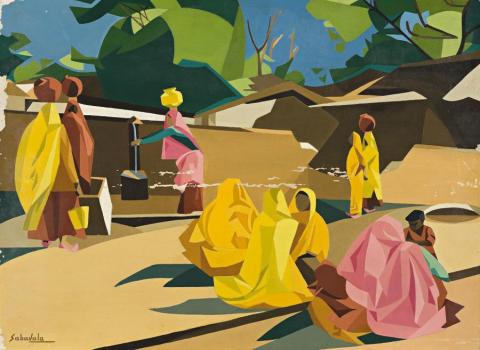THE WATERPUMP, JAIPUR, c.1955
JEHANGIR SABAVALA
oil on canvas
59.0 x 79.0 cm
signed lower left: Sabavala
artist's name and title inscribed on label verso
Collection of Sir Kenneth Wills and Lady Wills, Adelaide, acquired in Bombay (Mumbai), India, 1960s
Thence by descent
Private collection, Melbourne
Sabavala's return to India coincided with the numerous business expeditions of the South Australian businessman Sir Kenneth Wills who frequently travelled to Mumbai sourcing textiles for his family's prominent shipping and freight forwarding conglomerate, G and R Wills. Sir Kenneth had fought in both world wars and joined the family business in London in the interwar years finally relocating the company to Adelaide in 1946. An urbane and educated man, who went on to become Vice Chancellor of the University of Adelaide, Sir Kenneth was clearly impressed by Sabavala's paintings and purchased both The Water Pump, Jaipur and The Bundi Courtyard. Through his own extensive political, social and business networks it is highly likely he had met the aristocratic Sabavala family, 'whose history of commercial enterprise, cultural patronage and civic concern is closely entwined with the history of Bombay'.1 After all, Sabavala's family gave the city The Jehangir Art Gallery and endowed the Sir Cowasji Jehangir Hall, which now houses the National Gallery of Modern Art. Sir Kenneth brought the two paintings back to Adelaide where they hung in his family home until his death.
Clearly these two paintings were evocations of India and served as an aide memoire for the South Australian collector. Works from this period weave both the impressionist and cubist traditions internalised by Sabavala during his rigorous training under André Lhote in Paris. However, in the hands of Sabavala such formalities dissolved under the sharp Indian light and the 'subcontinent's excesses of colour' and abundance alongside the sumptuous and sensuous lines of Indian garments. The artist intuitively synthesized the formal elements of his training with the Indian world that lay before him. The result was an art all of his own. He commented that there was 'a great deal of intellectualising: the analysis of planes, the passages of light. I became more sure of how I wanted my painting fractured and adopted a definite form, a daring, high-pitched and high-keyed palette.'2 As such his paintings continue to evoke strong emotions in collectors the world over. As Ranjit Hoskote comments of his paintings, 'they are haunted by nostalgia, as for moments once possessed and now lost, for homelands once known and now forever beyond the horizon of what can be known... This is an art of mirage and apparition: it is defined by a geometrical spirit of order that strives to contain the passions, yet allows its deliberation to be defeated by impulse.'3
Long-time friend and fellow painter Richard Lannoy concludes that the mystery inherent in Sabavala's work, the elusive characteristic which keeps it eternally relevant, lies with the artist's belief that man and nature are one and that this unity is in some way hidden and unbreakable. Indeed, Sabavala himself commented on his own relationship to nature and his final destiny reflecting, 'I would like to end up like one of those smooth, round, fabulous pebbles you find awash in the Ganges at Rishikesh, all corners smoothed away but definite of shape and accepting - quiet.'4
1. Hoskote, R., Pilgrim, Exile, Sorcerer: The Painterly Evolution of Jehangir Sabavala, Eminence Designs, Mumbai, 1998, p. 21
2. Ibid, p. 65
3. Ibid, p. 20
4. Ibid, p. 16
